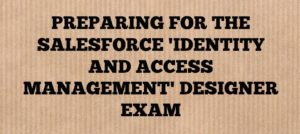I had my eyes set on the newly launched Architect Credentials for quite some time now so I finally decided to take the plunge and attempt the Salesforce Certified Development Lifecycle and Deployment credential. My current project gave me the opportunity to be a part of the entire development lifecycle which involved working in an Agile/Sprint based environment, providing requirement traceability, using a diverse range of deployment tools and having frequent communication with stakeholders/product owners/architects/data owners about the project lifecycle. I deemed it enough to take the exam and I fortunately wasn’t wrong. Majority of the exam content was based on governance, sandbox types and other development/production environments, deployment tools, release management, org architecture and testing types. I think I might have summed up the whole exam. If you are confident about these topics and have sufficient hands-on experience in these areas, you should definitely consider taking this exam.
Like most of the other exams offered by Salesforce, this one has 60 multiple choice questions, you are given 90 minutes to complete the exam and 68% is the passing score. One thing I would like to point out is that more than 80% of the questions were scenario based which meant long wordy questions hence calling for a good time management strategy. I did not purchase the Architect Domain Study Materials offered by Salesforce and instead went through the study guide topics, googled and then skimmed through them in the Salesforce help and training documentation. Without any further fuss, let’s see which topics are most important for the exam:
- Team Roles and Structures on a Project (Center of Excellence, Architecture Review Board, Executive Sponsor, Steering Committee etc.)
- How to use Governance to manage change? (Different constituents of governance)
- Development environments and which to use when? (Development, Integration, UAT, Staging, Regression, Defects Reproduction, Production environments)
- Different Sandbox Types and which to use when? (Developer, Developer Pro, Partial Copy, Full)
- Different deployment tools and which to use when? (Force.com IDE, Force.com Migration Tool, Changesets)
- Release Management (Continuous Integration, Source Control mechanisms and tools)
- Salesforce Releases and Development Release Schedule (The inter-dependency between these)
- Salesforce Org Architecture (Single Org, Multi Org and how to make two different salesforce orgs interact with each other)
- Testing the Force.com application (Unit test, Integration test, System test, Acceptance test, Performance test, Security test, Usability Test, Load Test, Stress test etc.)
- Waterfall and Agile methodologies (differences and when to use which)
Overall, I found the exam content to be similar to and at par with the other consultant exams (Service, Sales, Pardot) in terms of difficulty level and question style. If you have enough deployment experience and have worked with multiple sandboxes and a decent sized development team in the past, I feel that you can pass the exam with a few hours of preparation.
Good luck!



